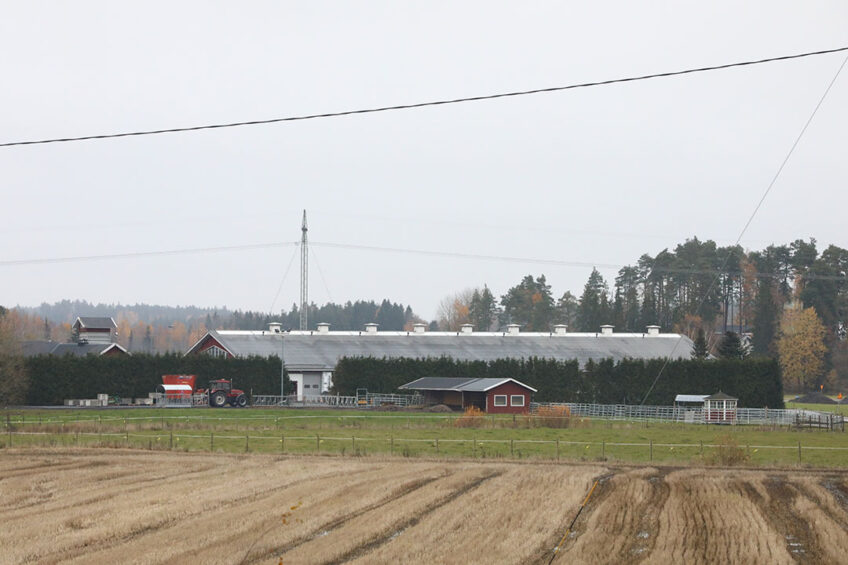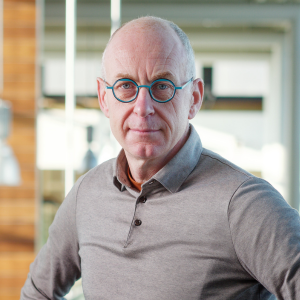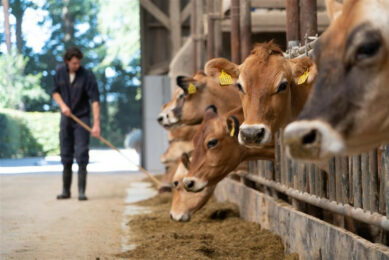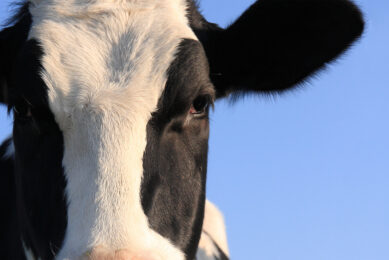Finland: Soya-free dairy production, locally grown protein

It is relatively easy for dairy farmers Jukka and Sinikka Tuominen to get a lot of milk from their cows: they feed them locally grown protein. As a result, they do not see much of the vet.
It is mid-morning and Finnish dairy farmers Jukka and Sinikka Tuominen are in their barn, which is equipped to receive groups. They will welcome thirty Icelandic guests the next day. The tables are set and a fire crackles in the fireplace. This is nice, because the temperature in the Scandinavian country does not exceed 5˚C in mid-October.
| Profile Jukka (58) and Sinikka (58) Tuominen milk 65 cows in Lieto, Finland. The farm consists of 170 hectares of land, 10 hectares of which are woodland. Together with other organic farmers, they work another 120 hectares of land to produce feed raw materials. Their most important crops are wheat, barley, oats, peas, lucerne and field beans. |
The morning is uneventful. Jukka and Sinikka have enough time for coffee and a conversation. The cows have already been fed and the 5-year-old Delaval robot does the milking. The barn is filled with a mixture of red and black and white cows. Out of the 62 cows, 28 are Holstein and 34 are Ayrshire. There is almost no difference between the breeds in terms of production, but the contents of the Ayrshires are higher. The Ayrshire cows have a firm physique and good, compact udders. The Holsteins are larger and slenderer. If it were up to them, the Tuominen family would like to see more Ayrshire cows in the barn. Nature however, decided differently. The Holsteins gave birth to quite a lot of heifer calves last year, maintaining the population.

The herd is relatively young. The cows on this farm have calved 2,9 times on average. There are 30 cows that calved more than 3 times. About 40% of the cows is inseminated by a beef bull, often a blonde d’Aquitaine. They calve easily, says Sinikka. She also inseminates the cows. According to the most recent numbers, the calving interval is 403 days. The heifers calve for the first time at 29 months. This is late and a point of concern, Sinikka acknowledges this without being asked.

Switch to organic
5 years ago, the farm made a radical transformation. The Tuominens switched from regular to organic production, built a new free stall barn and invested in a new robot with the Feed First system. This is a selection gate that directs the cows to a feeding computer, which selects the animals with milk permission. These can continue to the milk robot. Finally, the dairy herd has doubled to the current number of animals.

Opting for an organic operation has more than one reason. The land had already been organic for 4 years and fertiliser became more and more expensive. The Finnish fertiliser plant was privatised and Yara came to own it, explains Jukka. “Due to the increase of fertiliser prices, we decided to switch to organic.”
The cows pasture from the beginning of May until the end of September. They can go outside all year on a paved range next to the barn and only stay indoors when the weather is extremely bad.

The organic cows produce a large amount of milk. The Holsteins produce 10.837 kilogrammes annually, the Ayrshires yield 10.781 kilogrammes. They have unrestricted access to silage, which is a mix of 3 grasses, clover, lucerne and green peas. The fresh cows also receive a 5,5-kilogramme grain mix (wheat and barley) and 5 kilogrammes of peas and minerals. The farmers grow grain, peas and field beans to meet the demand for additional protein. Growing protein is a prerequisite since Finnish dairy farmers do not use soy.

Smooth production
The cows seem to be able to handle the production level quite well. The vet pays the farm a visit about 6 times a year. These visits are planned, for fertility examinations and dehorning young animals. If an extra visit is needed, it is mostly for a cow that has difficulties calving or is unable to stand up after calving. However, Ayrshire is a breed that needs little assistance calving.
The cooperative Finnish dairy company Valio processes the milk. The Tuominen family supplies their milk to mother company Valio through the regional cooperation Länsi-Maito. 2015 was a hard year for Finnish dairy farmers, Jukka explains. Quotas stopped and 6 months prior to that, neighbouring Russia closed its borders to European agricultural products. Especially the latter was a severe loss for Finnish dairy farmers: a fair number of them decided to quit. The country has been self-sufficient for dairy ever since, instead of being an exporter.
| Key figures Finnish dairy in 2018 Basic milk price: € 33,71 per 100 litres plus 57 cents premium Cattle: 882,000 animals Dairy cows: 271,000 animals Dairy farms: 6,263 National milk production: 2,33 million tonnes Production per cow per year: 8.650 litres Source: Finnish food information https://www.ruokatieto.fi/ |
The Finnish dairy market has since regained itself and processors pay competitive prices. Regular milk with 4,3% fat and 3,3% protein yielded 34,5 cents per kilogramme in mid-October. The selling price for organic milk is 13 cents higher. The Tuominen family receives 50 cents per litre in October, including premiums for contents. The Holsteins yield 4,2% fat and 3,46% protein. The Ayrshires’ milk contains 4,4% fat and 3,53% protein. Both the Holsteins and Ayrshires are pure-breds: there are no cross-breed in the barn.
Key figures Finnish dairy in 2018
Basic milk price: € 33,71 per 100 litres plus 57 cents premium
Cattle: 882,000 animals
Dairy cows: 271,000 animals
Dairy farms: 6,263
National milk production: 2,33 million tonnes
Production per cow per year: 8.650 litres
Source: Finnish food information https://www.ruokatieto.fi/
Join 13,000+ subscribers
Subscribe to our newsletter to stay updated about all the need-to-know content in the dairy sector, two times a week.










